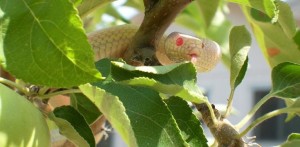
We are heading to the US Southwest today to find one of the most critically endangered species in the country: the Southern Mountain Yellow-legged Frog. This little critter is so endangered that Animal Planet actually lists it on their Top 5 Endangered Frogs list.
This creature is mainly found in the Sierra Nevada area of California. They range approximately between 2 and 3 inches (5 and 7.5 cm) in size, have orange or yellow coloring on their underside, yellow or red coloring on their topside, and black or brown spots. They love sunny riverbanks, lake borders, and meadow streams; unfortunately, there aren’t many left to enjoy their former territory. In fact, in the past century, more than 90% of their population has died out. Estimated population size (for those located south of the Sierra Nevada) in 2003 was about 183 and they are currently known to inhabit only 7 or 8 locations.
It’s claimed that when they are handled, they smell like garlic, but I wouldn’t try to eat them—they are severely threatened by pesticide use. Southern Mountain Yellow-legged Frogs are probably one of the worst hit species from windborne agricultural pesticides. A study conducted by Davidson and Knapp involved the surveying of 6831 bodies of water. The Southern Mountain Yellow-legged Frog was found at 13% (about 888) of the surveyed bodies of water, along with introduced fish species (which also pose a threat, but will be discussed later). At a number of the locations, the fish were removed and unfortunately, the frogs in those bodies of water failed to survive.
Apparently, research performed on the dead frogs from the areas with removed fish showed that the frogs had higher levels of pesticides in their tissue. Other research on amphibians in general shows that not only are pesticides dangerous in general, but they are also known to make the infected amphibian more vulnerable to disease.
One pesticide that poses the biggest threat to the Southern Mountain Yellow-legged Frog is Atrazine. Atrazine is a very dangerous pesticide; so dangerous that it has to be specially regulated by the EPA and the State of California. Only those certified by the state are allowed to use this pesticide and only under specific conditions. The toxicity levels in this pesticide are known to cause groundwater contamination, kill birds and fish, and even cause illness in humans including: cancer, lung and kidney damage, congestive heart failure, muscle degeneration and more. If it can do all that damage to a large human, imagine what it could do to a tiny frog; especially considering that Atrazine takes a long time to break down in the environment.
It may shock you to learn that pesticides can actually take decades to completely disappear from the environment and there are frogs that live in places where pesticides have not been used in years, yet they still have pesticides in their tissue because they get it from their home environment. This also has a damaging effect on tadpoles and juvenile frogs.
The good news is people around the world are fighting to reduce (and perhaps eliminate) pesticide use. The bad news is, these frogs are also threatened by pollution, human intrusion/disturbance, climate change, drought, introduced fish species (mainly Trout), ultraviolet radiation (which affects the eggs and developmental process), and the nasty, infectious fungal disease, chytridiomycosis, which is notoriously known to kill amphibians—especially frogs.
To find out more about the Southern Mountain Yellow-legged Frog (because there is far too much to write!), check out these links:
IUCN Red List
Wikipedia
The Mountain Yellow-Legged Frog Site
AmphibiaWeb
Western Soundscape Archive (frog sounds)
Save The Frogs!
CaliforniaHerps
Center for Biological Diversity
Reptile Channel
Southern California Camping: Field Guide to Plants and Animals
Sierra Forest Legacy
New Hope for Endangered Mountain Yellow-Legged Frog





